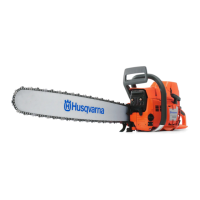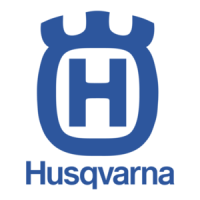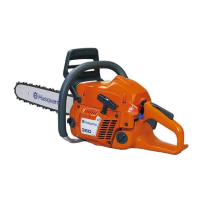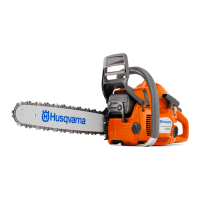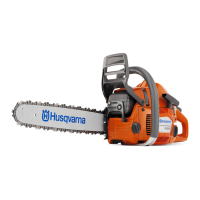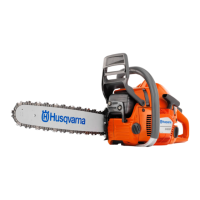Do you have a question about the Husqvarna 345 (EPA II) and is the answer not in the manual?
Explanation of symbols used in the manual and on the machine.
Details on mandatory safety gear for operating the chain saw safely.
Description and function of the chain saw's built-in safety features.
Explains the chain brake mechanism and the hand guard's role.
Information on the system designed to minimize vibration during operation.
Explains the function of the throttle lock to prevent accidental throttle operation.
Describes the chain catcher's function to stop the chain if it jumps or snaps.
Details the right hand guard's protective function for the operator's hand.
Instructions on how to use the stop switch to turn off the engine.
Details on the muffler's function and maintenance, including spark arrestor.
Procedures for inspecting and maintaining the safety features of the machine.
Procedure to check the brake trigger for proper function.
Guidance on choosing and maintaining cutting equipment.
Information on selecting and using equipment to reduce kickback risk.
Detailed instructions on sharpening cutting teeth and setting raker clearance.
Procedure for adjusting the raker clearance using a gauge.
Instructions on how to properly tension the chain saw chain.
Guidance on using chain oil and ensuring proper lubrication of the cutting equipment.
Instructions on how to fill the chain oil tank and system checks.
How to verify that the chain lubrication system is working correctly.
Procedure for lubricating the bar tip sprocket with grease.
Instructions on greasing the needle bearing on the drive shaft.
Daily checks for wear on the chain, bar, and drive sprocket.
Detailed explanation of kickback causes and prevention methods.
Definition and explanation of the kickback phenomenon in chain saws.
General safety rules and precautions for using the chain saw.
Step-by-step instructions for starting the chain saw engine.
Important precautions for safe handling of fuel and potential fire risks.
Guidelines for safe transport and storage of the chain saw and fuel.
Basic safety rules and advice for general chain saw operation.
Essential safety rules to follow during general chain saw use.
General principles and techniques for effective and safe cutting.
Specific techniques for cutting logs lying on the ground.
Instructions and safety considerations for felling trees.
Guidelines for maintaining a safe distance during tree felling operations.
Factors influencing and controlling the direction of tree fall.
Techniques for safely removing branches from a felled tree.
Steps to clear the work area and prepare a safe retreat path.
Procedure for making the felling cut to control tree fall.
Methods for safely freeing a trapped tree.
Techniques for cutting tensioned wood safely.
Identification of all parts of the chain saw with numbered labels.
Step-by-step guide for attaching the bar and chain to the saw.
Information on gasoline and two-stroke oil types and mixing ratios.
Instructions on how to correctly mix gasoline and two-stroke oil.
Details on chain oil types, viscosity, and recommendations.
Precautions and procedure for safely refuelling the chain saw.
Instructions for starting and stopping the chain saw engine.
Procedure for starting the engine when it is cold.
Procedure for starting the engine when it is warm.
Procedure for safely stopping the chain saw engine.
Information on carburettor function, settings, and fine adjustment.
Instructions for fitting, changing starter cords and springs.
Guidance on cleaning and replacing the air filter.
Information on spark plug condition, cleaning, and replacement.
Details on the muffler's function and maintenance, including spark arrestor.
Procedure for lubricating the needle bearing on the drive shaft.
Instructions on adjusting the oil pump for correct chain lubrication.
Information about the machine's cooling system and its maintenance.
Explanation and maintenance of the air injection centrifugal cleaning system.
Measures and adjustments for operating the saw in cold weather.
Routine checks and maintenance to be performed daily.
Maintenance tasks to be performed on a weekly basis.
Maintenance tasks to be performed on a monthly basis.
Specifications for engine, bar, chain, and recommended combinations.
Overview of owner's responsibilities and warranty coverage for emission control.
